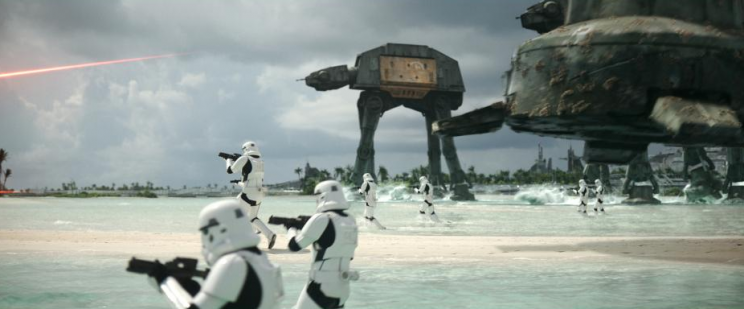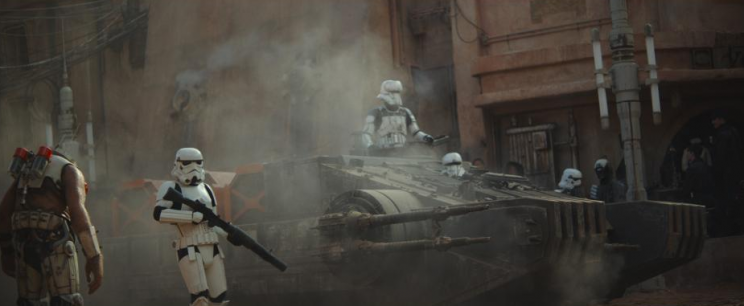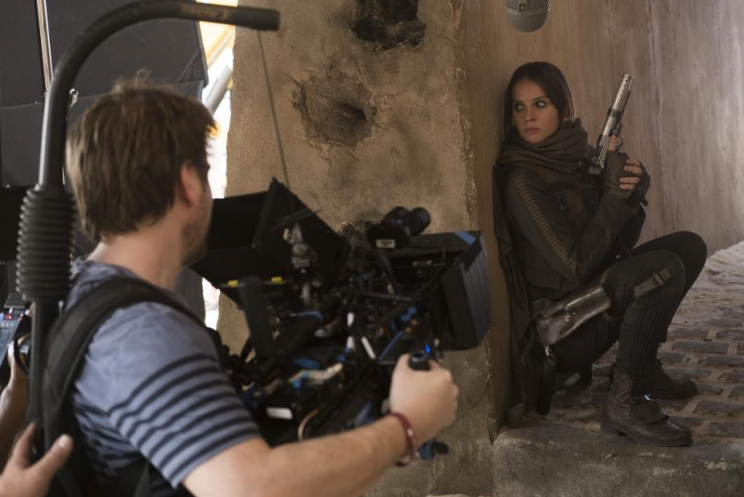'Rogue One' Special-Effects Supervisor Neil Corbould on 'Star Wars' Battles, Darth Vader's Fight Scene, and Practical FX in 'Alien: Covenant'

When it comes to blowing stuff up for the big-screen, Hollywood’s blockbuster directors turn to Neil Corbould, who over the course of a four-decade career has handled the practical effects for a wealth of illustrious films, including Superman, The Fifth Element, Saving Private Ryan, Black Hawk Down, Superman Returns, War Horse, and The Martian. A five-time Oscar nominee and two-time winner (for Gladiator and Gravity), Corbould’s latest venture was perhaps his most widely seen — Rogue One: A Star Wars Story, which served as his maiden trip to the galaxy far, far away. With Rogue One arriving on Blu-ray release today, we spoke with the special effects supervisor about giving the movie its wartime style, the relationship between practical and digital effects, and setting off explosions around Darth Vader — as well as his upcoming work on Alien: Covenant and Mission: Impossible 6.
Looking back on Rogue One, what was the most challenging effect you were tasked with — and how did you successfully tackle it?
From my side, I’m the practical-effects supervisor, so I was in charge of all of the explosions, atmospheric effects, bullet hits and that sort of stuff. So for me, the biggest challenge was the battle sequence of Scarif, and the planning and the look of it as well. Because when I first met [director] Gareth [Edwards], his brief to me was that he wanted it to be a war movie. You know, it’s Star Wars, and he wanted to emphasize the war in the movie. He said to look at Black Hawk Down and Saving Private Ryan and Apocalypse Now, which was great for me because I did Black Hawk Down and Saving Private Ryan! [Laughs.]

It was music to my ears, because it gave me a great starting point. It was an interesting process, bringing the Private Ryan and Black Hawk Down battles into a Star Wars movie, and giving it a Star Wars twist. It was challenging, but it was a lot of fun in the process.
How do you go about giving it that “Star Wars twist”?
It starts with, I watched A New Hope again, like six times, just to get a feel. Then, I took another at Black Hawk Down, and had discussions with Gareth, who wanted to shoot in a guerrilla-documentary style, handheld. After that, it was about taking the Saving Private Ryan explosions and just putting in a few different colored sparks. We also developed a new air canon, for a nitrogen canon explosion effect, so we could get actors very close to the explosions. It was combining new technology with old techniques, and then making it a Star Wars war movie.
Rogue One obviously has to work somewhat seamlessly with A New Hope. Did that present any restrictions in terms of what you could or couldn’t do — or did you have a free rein?
We had a free rein, but I didn’t want to go too far. I didn’t want to create all these different types of explosions, with huge sparks and stuff like that, because I’m such a fan of A New Hope; I didn’t want to change it too much. We had a bit of license, because it was shot a lot grittier. People get dirtier in it and are covered in sand, and we’re blowing up stormtroopers, and their costumes are a wreck — it’s not like they land and they’re pristine. There’s a gritty feel to it. We embraced that, and for me, I know I worked on the movie, but it was one of the best Star Wars movies — it just felt real, and I felt a part of it. In those battle sequences, I felt you really get involved. You’re there with them.

Did you have anything to do with the climactic Darth Vader action sequence?
Only with regards to the pyrotechnics going off around him. It’s such an iconic shot for me, and sent shivers up my spine as it’s going on — Darth Vader in the middle of these huge effects that we’re doing. It was awesome to be a part of, I have to say.
Blockbusters like Rogue One are overflowing with digital effects. From your practical-effects side of things, has it become easier to work with CGI?
Ten years ago, there were some visual effects supervisors who were telling me that we (practical effects people) would be a thing of the past. Which sort of made me laugh a bit, because now, we’re probably stronger in practical effects than we’ve ever been. Directors can see the advantage of doing things practically — it’s safer, as well — and using special effects and visual effects as a toolbox, and just picking the right tool to do the right job. Of course, you can shoot all of Rogue One digitally, and have the guys running around in a green box. But [visual-effects supervisor] John Knoll was great, because he just said to me — do as much practically as you can. I said, “Well, what about smoke?,” because normally, visual-effects people don’t like smoke. He said, “Put in as much smoke as you like and we’ll make it blend into the background.” That’s why I think Rogue One really works, because I don’t think you can see where we stop and they take over. That’s the secret of a great movie.
You must work closely with VFX people, to make sure all these issues are worked out ahead of time.
Absolutely. It’s a constant conversation between us. I don’t want to surprise John by doing something that he can’t fix in post. And Gareth puts his three pennies’ worth in as well. So when we get to the set, we all know what we’re doing, and John knows what he has to do afterwards. John is a legend in the visual effects world. It’s quite a daunting task for me to work with him, but so rewarding — we really got on very well together. I’d certainly jump at the chance to work with him again.

This was your first Star Wars film. Was it always a dream to get to contribute to the franchise? And is there extra pressure working on these films, given the expectations and legacy?
Yeah. I didn’t think I’d ever get a chance to work on one. My brother Chris did The Force Awakens, and I actually thought that he’d go one and do the rest of them. But given the chance to do Rogue One, I absolutely jumped at it. There was a lot of pressure, because it’s so tightly related to A New Hope — it really was like, “I can’t screw this up!” Because then everyone would be like, “He’s the one who worked on that really bad one.” [laughs] I didn’t want that to happen. But I think we got the balance right, between real sets and visual effects. The blend was perfect for me, and I thoroughly enjoyed the movie as a movie, not just looking at the effects work. It didn’t make me think about whether anything was an effect or not.
You’ve now moved on to Alien: Covenant, another big entry in an illustrious sci-fi franchise…
How lucky am I? [laughs]
Despite both being sci-fi, what were the differences for you, in terms of working on Rogue One vs. Alien: Covenant?
Rogue One was very much a PG-13 movie and Alien is very much an R-rated movie, so we did a lot gorier stuff on Alien — which, I think, is what the audience wants. I think after Prometheus, some were a little disappointed — Prometheus was really there to start a story off. So they’re very different movies, Rogue One and Alien: Covenant, and I’m very happy I’ve worked on both of them. I really hope that I get another chance to work on another Star Wars movie as well.
You’ve collaborated with Ridley Scott a number of times. Was it cool to finally get to work with the H.R. Giger-inspired aliens? Or were those all digital?
No, again, it was a big mixture. Ridley’s a very practical, hands-on person. Wherever we could, we’d have an alien in the shot. So yeah, it was a very practical shoot.
I know you’re also now working on the new Mission: Impossible — anything you can tell us about the stunt/sequence that required Tom Cruise to spend a year training for?
All I can say is it’s going to be amazing! [laughs]
Watch: Rogue One From Concept to Screen
Read more from Yahoo Movies:

 Yahoo Movies
Yahoo Movies 
